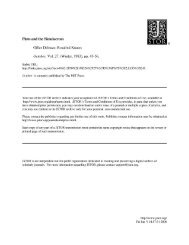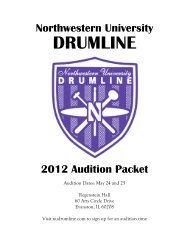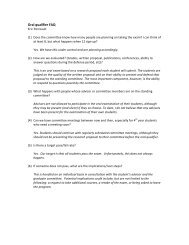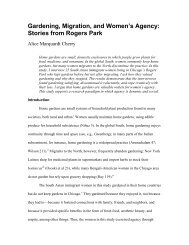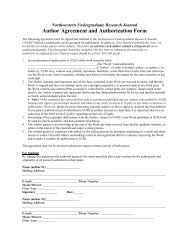research - Associated Student Government, Northwestern University
research - Associated Student Government, Northwestern University
research - Associated Student Government, Northwestern University
You also want an ePaper? Increase the reach of your titles
YUMPU automatically turns print PDFs into web optimized ePapers that Google loves.
RESEARCHthe world have called for China to allow the Renminbi to appreciate but the US has stopped short of brandingChina a currency manipulator. The president of the People’s Republic of China, Wen Jiabao, has rejected foreignpressure so far but recently Zhou Xiaochuan, governor of the People’s Bank of China, alluded to the peg of the RMBto the dollar being temporary—possibly setting the stage for an appreciation. 2 However, it is unclear whether anappreciation of the RMB would be advantageous for China due to the decline in value of their large holdings of USTreasury bills as well as the decline in trade that an appreciation would cause.Demand theory predicts that if the price of China’s exports to the United States relative to US domestic goodsincreases, then the quantity of China’s exports demanded by the US will decrease as a result of relative price changes ornominal exchange rate changes. In international trade, the value of trade flows has been shown to follow a J-curve—initially the value of trade actually increases after the relative price of imports increases because trade quantities donot adjust immediately. Usually after an adjustment period varying from a couple months to a few years the quantityof imports demanded adjusts and the value decreases. The relative price increase will decrease the trade balance onlyif the Marshall-Lerner condition is met, namely the difference between the price elasticities of import demand andexport demand is greater than one. This paper applies three frameworks to China that have been used previously tostudy trade relationships in several other countries but separates the nominal exchange rate and relative price variablesin order to account for possible differences in elasticities and adjustment rates. In addition, I use a vector errorcorrection model to study possible endogeneity and feedback effects within the model. These variables include the realexchange rates between the US and China as well as between the US and the OECD minus the US (henceforth referredto as OECDX), real GDP of these three areas, and the US-China bilateral trade balance.I find evidence that the China-US trade relationship does satisfy the Marshall-Lerner condition. Thus, anincrease in the real exchange rate would lead to a decrease in the magnitude of the trade deficit between the US andChina. I also find evidence of the J-curve and a decrease in the value of imports within two years in response to arelative price increase of Chinese goods. Furthermore, I find that the value of China’s imports to the United Statesadjusts more quickly but less strongly to changes in the nominal exchange rate than to changes in relative prices. Thethird part of the model shows the sensitivity of China’s real GDP to the value of its exports.The remainder of the paper is organized into six sections as follows: Section II summarizes previous <strong>research</strong>related to the topic and discusses where this paper builds upon the current <strong>research</strong>; Section III describes the dataas well as their possible shortcomings; Section IV describes the vector error correction models and discuses thoseresults; Section V concludes and suggests how the findings should affect China’s and the US’s trade policies andpossible areas for further <strong>research</strong>.Section II. Literature ReviewWhile the effects of real exchange rates on trade flows have been widely studied by economists, there are nouniversal truths about the ways in which trade flows behave. Paul Krugman constructs a demand equation forthe United States’ exports to the rest of the world and one for imports to the United States in order to study theUS’s growing trade deficit, especially with Japan, despite the weakening dollar. 3 He finds that from 1977 to 1985the import elasticity of real US expenditure to be 2.78 and the elasticity of the real exchange rate to be .92. For USexports he finds a foreign income elasticity of 2.47 and an elasticity of -1.40 for the real exchange rate using theforeign economy as the rest of the world. These two equations show that US exports are more responsive to thereal exchange rate than its imports, which suggests that any real appreciation of the dollar will decrease net exports.Another model of international trade is the vector error correction model used by Yusoff to estimate the effects ofreal gross domestic product of both Malaysia and its foreign trade partners and the real exchange rate on the bilateraltrade balance. 4 Yusoff also uses a two-step model that allows him to determine whether a bilateral trade relationshipsatisfies the Marshall-Lerner condition. By separating the trade balance regression into an equation for exports andan equation for imports, he averts the problem of having to take the log of the trade balance when it is negative.Narayan and Narayan also use an error correction model in their analysis of Fiji’s import demand function. 5 Theyfirst-difference all of the variables in their model and include an error correction term to account for any unit-rootsand any shocks to the system. The independent variables in the import demand function include lagged imports,domestic real GDP and the price of imports relative to domestic prices. Indeed, my own vector error correctionmodel is very similar as it is derived from the same logic that Narayan and Narayan use to construct their model,though I apply it to China, the US, and the OECDX.2 Dyer, Geoff. “FT.com / China - Beijing studies severing peg to US dollar.” 11 Mar 2010.3 Krugman, Paul et al. “The Persistence of the U.S. Trade Deficit.” Brookings Papers on Economic Activity. Vol. 1 (1987).4 Yusoff, Mohammed. “Bilateral Trade Balance, Exchange Rates, and Income: Evidence from Malaysia.” Global Economy Journal. Vol. 9, Iss. 4 (2009): Article 7.5 Narayan, Paresh and Seema Narayan. “Estimating Income and Price Elasticities of Imports for Fiji in a Cointegration Framework.” Economic Modelling. Vol. 22 (2005): 423– 438.VOLUME 7, 2011-2012NORTHWESTERN UNDERGRADUATE RESEARCH JOURNAL21




